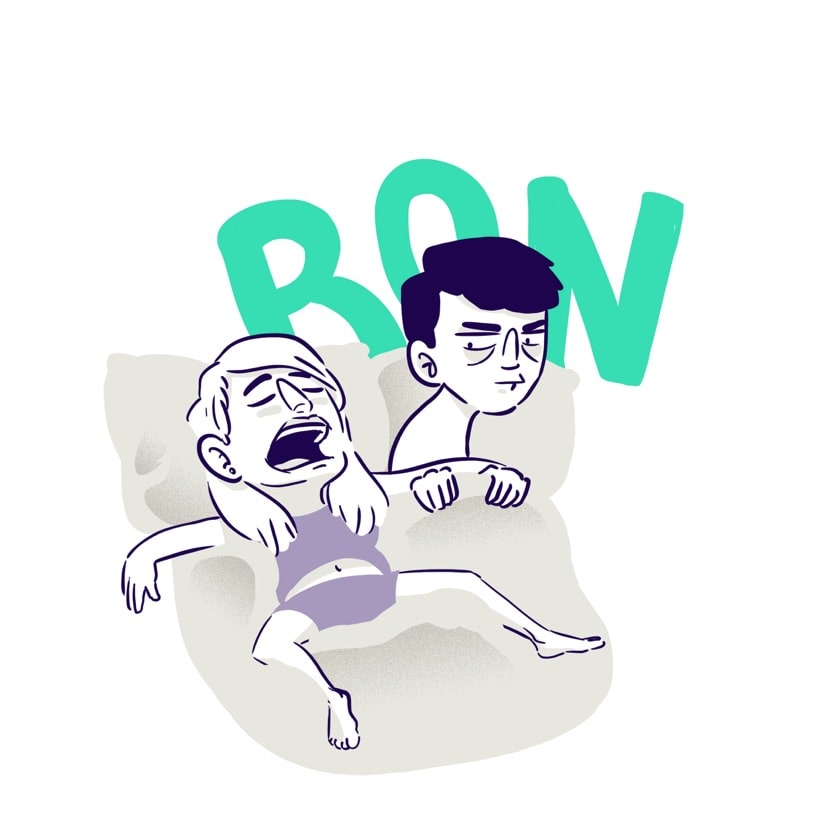Snoring: a symphony in the night!
It rhymes with annoying, restrictive, but above all with noisy. It is a melody (not that of happiness!) which punctuates our nights a little too often, and one of the major causes of the "separate bedroom" syndrome for couples, when it is not the origin of marital reprimands, or even disapproving and desperate nudges. As you will have understood, it is indeed snoring that we are talking about here!
Beyond the smiles and sometimes amusing anecdotes at the mention of its name, this sleep-related breathing disorder is not so banal or harmless, as it has a real impact on the quality of sleep of the person who suffers from it, but also of their partner, or rather their partner in the majority of cases. We can read or hear a lot of things about this noisy phenomenon. What can be done about snoring ? Are there effective solutions to stop snoring ? Here's what you need to know about snoring, those noises we would prefer not to hear anymore!

What is snoring?
Snoring, also called ronchopathy , is a vibration of the pharynx. The relaxation of the muscles of the soft palate, the back of the throat, the uvula, and the tongue, creates a narrowing of the airways. During breathing, the passage of air is disrupted by the obstruction of the airways, which causes the soft tissues of the palate and the uvula to vibrate. The more the airways are obstructed, the greater the effort to inhale and exhale, and therefore the greater the intensity of the snoring.
Speaking of intensity, it turns out that snoring can be very loud. In fact, an "average" snore is generally measured between 45 and 60 dB (decibels), which would correspond to the loudness of a voice. However, some intense snores have been measured as high as 90 dB, which is equivalent to the noise made by a moving truck. Sleep or drive (the truck), you have to choose!
Snoring is often associated with another major breathing disorder, namely sleep apnea . Snoring is indeed a symptom of this condition, and its association with the latter is anything but trivial given the consequences of obstructive sleep apnea , which can be very harmful to health.
Snoring figures
Snorers are relatively numerous! This respiratory disorder is in fact quite widespread, as revealed in particular by a 2005 study 1 carried out on more than 1,200 people. It appears, on average, that 8.9% of women snore, while this would be the case for nearly 29.5% of men. Regarding so-called "severe" snoring, it only affects 2.1% of women compared to nearly 10% of men. We can thus see that the prevalence of snoring is higher in men than in women. This study reports that in cases of severe snoring, it was sufficiently bothersome that "roommates left the room" to sleep in another room.
Furthermore, it seems that as we age, the proportion of snorers in the population increases. A survey carried out by the Sleep Foundation in the United States in 2003 revealed that more than "40% of people aged 55 to 64 reported snoring at least a few nights a week" and that men were "more likely than women to snore at least a few nights a week" ("40% versus 26%").
What causes snoring?
The association between obstructive sleep apnea and snoring can be explained by their origins. Indeed, the main causes of snoring 2 are the same as for OSA:
- obesity , overweight: excess fat accumulates in the neck and reduces the flow of the airways
- Age : Loss of muscle tone due to aging promotes relaxation of the soft palate, tongue, uvula and muscles of the back of the throat
- nasal or nasopharyngeal obstruction : allergic rhinitis, nasopharyngitis, angina, anatomical malformation (surgical history, anatomical component, craniofacial anomaly, etc.)
- consumption of tobacco, alcohol, sleeping pills
- sleeping on your back : causes narrowing of the airways
In addition to the above-mentioned factors, certain categories of people may be considered “at risk” for snoring :
- children : particularly due to enlarged tonsils, 12% of children are said to suffer from snoring 3
- men : between 30 and 50 years old, 60% of snorers are men 4
- Pregnant women : Nearly 42% of pregnant women snore during the third trimester of pregnancy 5 , partly due to weight gain
On the other hand, a 2016 study 6 showed that after the age of 50, the proportion of women who snore increases significantly, reaching the same level as that of men after the age of 60. This is probably due to menopause (action of progesterone) and the resulting less good protection of tissues.
Symptoms and Diagnosis of Snoring
Here again, the symptoms of snoring are similar to those of obstructive sleep apnea , but the main manifestation of snoring is of course the characteristic noise of vibrations that occurs during the night, with its share of decibels and awakenings (especially for the spouse!):
- snoring noise
- fatigue, daytime sleepiness
- headaches
- problems with concentration and memory
- irritability

Bad moods in your spouse, roommate, family members, or anyone who has had to endure nighttime noise aggression are also symptoms to consider! If this happens repeatedly, it's probably time to see a doctor. How can snoring be diagnosed?
In case of "alert" in view of the symptoms of snoring, essentially the noise it causes and which can be the clearest sign, it is advisable to consult a doctor. The doctor carries out a clinical examination to check for a possible obstruction of the airways . He checks the soft palate to highlight the presence of false pillars or thickened posterior pillars which could be at the origin of the narrowing of the oropharynx. He may also note a thickening of the uvula or any other anomaly such as a deviation of the nasal septum, or even hypertrophy of the turbinates.
Other more in-depth examinations may be necessary to reveal certain anomalies, check the quality of sleep or identify associated pathologies (sleep apnea):
- polysomnography : a comprehensive reference examination to measure various physiological variables during sleep (respiratory and cardiac rhythms, electroencephalogram, electromyogram, etc.)
- imaging : MRI, CT scan
- chest x-ray
- electrocardiogram
- respiratory function tests
- biological assessment
What treatments are there to combat snoring?
It is entirely possible to combat snoring effectively. You can sleep better, improve the quality of your sleep, make breathing easier, or even stop snoring thanks to certain anti-snoring devices or surgery, but before that, a healthy lifestyle can already help limit snoring.
First of all, you should avoid things that can “cause you to snore” :
- smoke
- consume alcohol
- take sleeping pills
Then, you can try changing your sleeping position, avoiding sleeping on your back. In addition, losing weight is a real anti-snoring factor, as confirmed by certain studies 7 : a weight loss of up to 7 kg can even lead to "a virtual elimination of snoring" when combined with a change in sleeping position and the use of a decongestant nasal spray!
Non-surgical treatments also offer good results:
- mandibular advancement splints or "mouth guards": this is a type of mouth guard that effectively keeps the lower jaw in a forward position, which helps open the airways by preventing the tongue from sinking to the back of the throat during sleep
- spontaneous positive airway pressure ("PPC" or "CPAP"): continuous ventilation device allowing the airways to be kept open (using a mask) to help the passage of air during the night
- nasal strips or nasal dilator
- nasal spray
There are other anti-snoring "remedies" or solutions whose effectiveness is not clearly established, including essential oils (peppermint, eucalyptus), acupuncture, lozenges, and anti-snoring pillows. In addition, for the "collateral victims" of snoring, good old earplugs are highly recommended!
Finally, when other treatments are insufficient or ineffective, it is sometimes necessary to resort to surgical treatments and consult an ENT specialist in order to cure snoring:
- septoplasty : correction of nasal septum deviation
- tonsillectomy , removal of adenoids
- somnoplasty : intervention on the soft palate, either by laser (abrasive and under general anesthesia), or by radiofrequency (less abrasive and under local anesthesia), or by surgery
- pharyngotomy : surgical intervention under general anesthesia in cases of very severe snoring associated with sleep apnea, the uvula and part of the soft palate are removed, as well as the upper part of the tonsillar pillars
- vaporization of the oropharynx with a “CO2 laser”
As with obstructive sleep apnea, any procedure involving anesthesia carries risks related to loss of muscle tone and one must be vigilant about the post-operative complications that may result.
Snoring is therefore a respiratory disorder that can be treated in several ways, surgery not necessarily being the first option. Indeed, lifestyle and anti-snoring devices, among others, provide satisfactory results in combating snoring, and thus allow you to sleep better. While snoring is not in itself dangerous for your health, it can be a symptom of more serious respiratory disorders (sleep apnea), and should not be overlooked. In addition, the social impact on those around the snorer is very real .
The available anti-snoring treatments and devices provide validated and convincing results. We are therefore not obliged to resort to solutions such as sleeping in separate rooms or, as in a famous film (with a certain Louis De Funès), to resort to subterfuges that are not always very convincing, although very entertaining to watch!
To smile for a few moments, here is an excerpt from the film " La Grande Vadrouille ", published by "Rue du bien-être" on "Youtube", and its famous snoring scene! Perhaps try it at home if necessary!
Sources:
[1] The prevalence of snoring in adult population , CO Kara, M. Zencir et al, “ Journal of Ear, Nose and Throat ”, 2005 [2] Common Causes of Snoring , “SleepFoundation” site, 2020 [3] Sleep-disordered breathing in children , S. Cohen-Gogo, J.Métreau et al, “ Archives de pédiatrie ”, February 2009 [4] and [6] The gender difference of snore distribution and increased tendency to snore in women with menopausal syndrome: a general population study , Li-Pang Chuang, Shih-Wei Lin et al, “ Sleep and Breathing ”, December 2016 [5] Sleep disordered breathing in pregnancy , BI Balserak, “ Breath ”, December 2015 [7] Treatment for snoring. Combined weight loss, sleeping on side, and nasal spray , HM Braver, AJ Block et al, “ Chest. », May 1995 [8] Oral appliances for the treatment of snoring and obstructive sleep apnea: a review , W. Schmidt-Nowara, A. Lowe et al, “ Sleep ”, 1995


